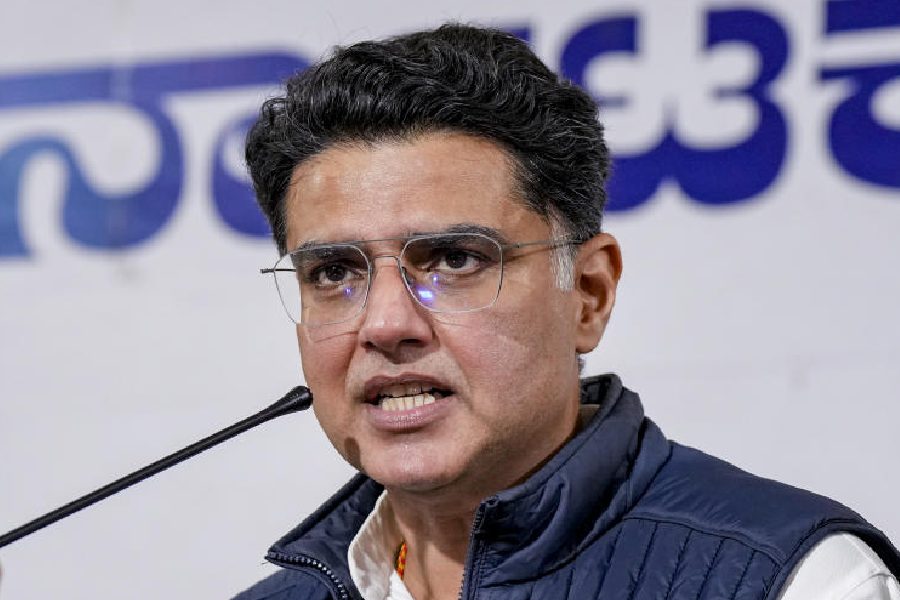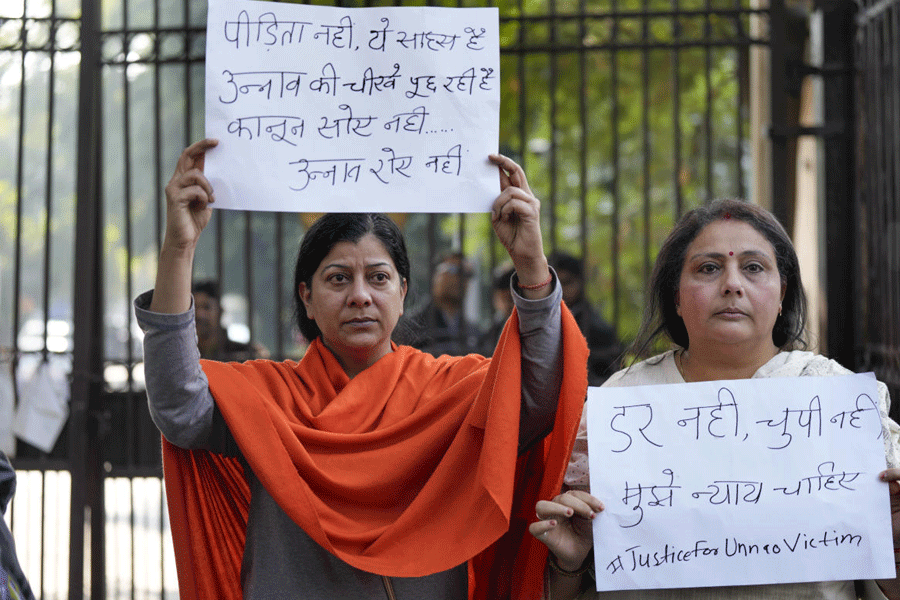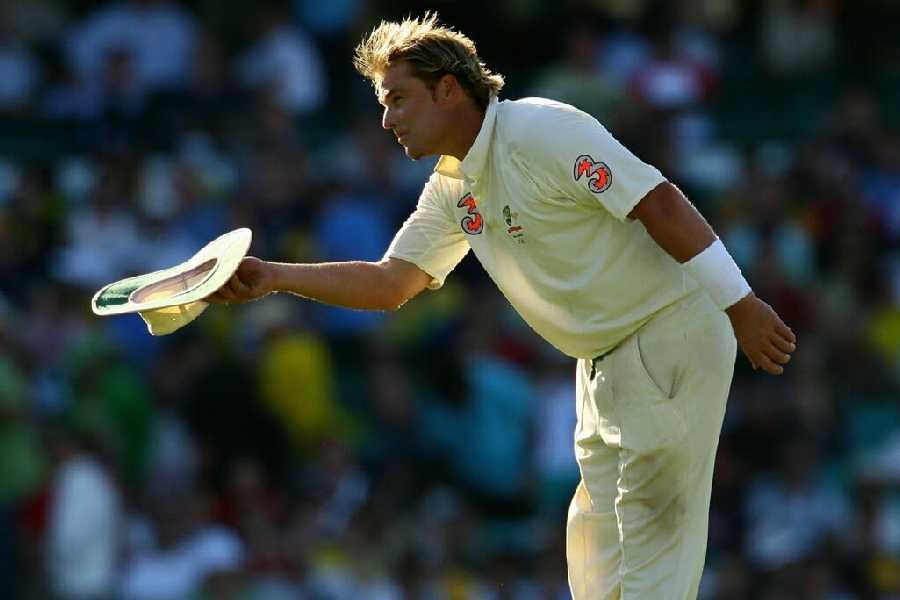|
|
For 75 years now, Bengalis have woken up once every 365 days at the ungodly hour of 4 am, turned on their radios and listened to stotras and songs marking the beginning of Durga’s journey to earth. And for most of these years, it has been the same programme, Mahishasurmardini — that legendary collaboration of Bani Kumar, Pankaj Mullick and Birendra Krishna Bhadra. But what looks like a boringly familiar custom can, in fact, be seen as a sign of great change. A programme born in the hallowed interiors of All India Radio, and once synonymous with Calcutta A, has moved out of the boundaries of the ‘primary channel’ (though it is still aired in Calcutta A), and come into the market in the form of a compact disc. As a result, Mahishasurmardini reaches more households today via FM channels, both AIR’s own and private ones, than through Calcutta A. The reason, however, has less to do with listeners turning away from Calcutta A than with the vastly superior transmission quality of the FM channels.
If people have turned away from anything at all, it has been the idea of radio as a State-controlled medium, higher on spoken-word content than on music. The proliferating FM channels today, most of them boasting up to 90 per cent song content, leave no room for doubt on this. It is important for these channels to fix their target audience at the very outset, and most target the age-group between 18 and 30. Youth is the keyword everywhere. Ironically, Yuva-vani, the medium-wave station dedicated to programmes for and by young people, has had to shut shop and be content with a few hours every day on Calcutta B. But listening to Calcutta B is next to impossible because of poor transmission. It is not only youth programmes that suffer because of this, but the whole bouquet of Western music programmes (including classical) that no FM channel, not even AIR’s own, cares to play. If you ask why the MW transmission system has not been upgraded, you are likely to hear that the Prasar Bharati board, upon noting that the primary channels were not half as popular as FM, has decided to concentrate on the latter. But many of those who have allegedly shifted allegiance have done so only because of poor transmission.
Modern India is a place curiously opposed to the flourishing of a heterogeneous culture. Lovers of both Eastern and Western classical music, being in the minority among listeners, get short shrift from the private FM channels. AIR’s FM channels, Rainbow and Gold, too, have pushed Eastern classical music from the mid-morning slots to the late-night ones. Another group of disgruntled listeners liked the talks on politics, diplomacy and sports on Calcutta A and B, programmes on career-counselling and vocational training for the youth that FM channels today wouldn’t be seen touching with a bargepole. Many of these programmes still feature on the primary channels, and some even on FM, but in the absence of weekly or daily listings or a Betaar Jagat, it is impossible to know which channel to tune in to, and when.
But few miss radio listings, because only a few listen to the radio with any great attention. In fact, the radio listener of today lives in the moment, and FM channels design their programmes armed with this knowledge. While some programmes on TV still get exclusive attention from viewers, a radio-listener is taken to be someone who is listening in addition to doing something else. In other words, his brain cannot receive anything more serious than light, filmi music. The greatest paradox of radio after the FM revolution, perhaps, is that it does not have time for those who have time for it. Mihir Bandyopadhyay — who had worked at AIR from 1965 to 2001, and now presents two popular programmes on AIR FM Gold — points out that radio has its most dedicated listeners in the villages and suburbs, and among the blind and the retired. The programming executives of two private channels confirm that it does not make business sense for them to cater to the tastes of the 60-70 age group. In this, they are guided by market-research surveys. Terms like RAM (Radio Audience Measurement) and TAR (Target Audience Rating) are to them what letters from the listeners were to AIR once upon a time. These days, even AIR has its own audience research unit. Private FM channels are revenue-earning entities, and can hardly be blamed for trying to maximize profit, even if it means playing ad-jingles in the middle of Birendra Krishna Bhadra’s chandi-paath. But AIR, under the Prasar Bharati board, need not always be propelled by the profit-motive.
It must be said here that private FM channels and AIR are as different as apples and oranges. Unlike the former, AIR is an institution with a history. To talk about AIR is also to talk about ‘radio artists’, a phenomenon that is altogether absent from FM radio. Being an artist of the B-high or A grade of AIR was once a matter of great prestige. Today, even the top-grade artists get no more than one programme a year. Ratna Sen, a senior announcer and presenter with Calcutta B and AIR FM, speaks of the thriving tradition of concerts by city musicians in the studios, some of which she now retrieves from the archives to replay in the Western music programmes she presents. The Rabindrasangeet singer, Ashis Bhattacharjee, recalls a time when tabla-players like Shyamal Bose and Keramatullah Khan would wait patiently for singers who had only just cleared their auditions. Today, the studios are unkempt, accompanists lackadaisical and authorities unconcerned. The one good thing that has been carried over is the Radio Sangeet Sammelan, a feast for Indian classical music lovers over two months in the second half of the year.
While Prasar Bharati, with all its noble intentions, is yet to free its purse strings from the government, it has inched closer to the private players in terms of appointments by contract. The result, according to Sobhan Pathak, who was with Betaar Jagat and a producer of radio-plays too, is the growing intellectual vacuity of programmes on AIR. Its presenters were once consulted by researchers and scholars, so impressive was their knowledge of literature and of the performing arts. “Today’s presenters do not know the difference between Bimal Ghosh, the writer with the pseudonym Moumachhi, and Bimal Ghosh the lyricist of Ujjwal ek-jhaank payra,” says Bandyopadhyay. The private FM channels, barring a few, do not, of course, have to worry on this count. Theirs is not to tell the stories behind the songs. Or to produce programmes that might stand the test of time, as Mahishasurmardini has.












